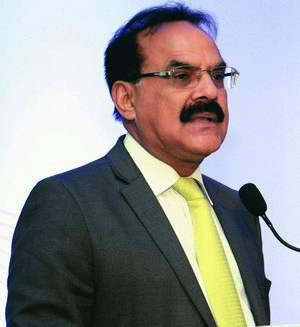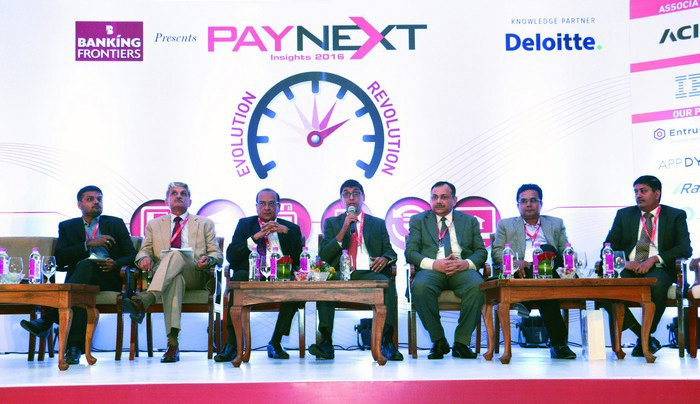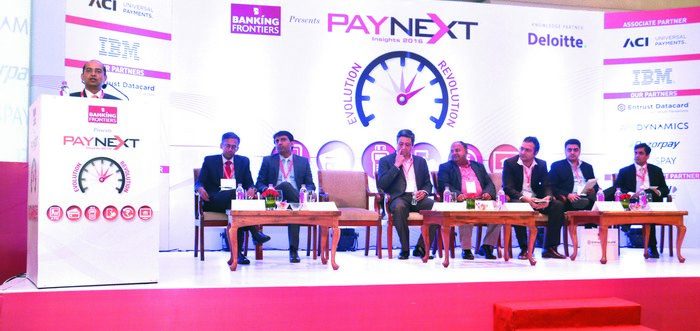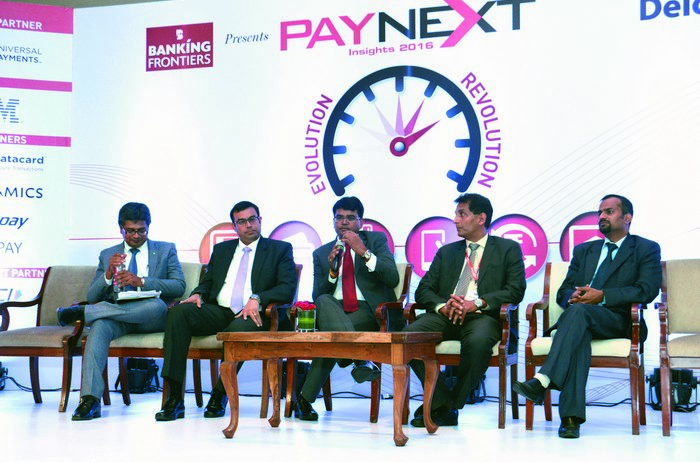Banking Frontiers organized the fourth edition of PayNext Insights conference, highlighting the recent innovations in the payments space. Here are the highlights of the conference
Payments system stakeholders in the country have to take into account the level innovation in the payments system across the world, in order to be ready to meet the increasing customer requirements. New systems that are becoming norms and the changing customer expectations from banks and payment service providers are challenges these entities have to encounter. Today there are non-banking companies emerging in the payments scenario and payments is now a critical factor for the banks in their strategy formulation. PayNext Insights 2016 held in Mumbai recently discussed these core issues with participants actively encouraging discussions and deliberations.
Some of the topics that were discussed at the summit were ‘Challengers vs legacy banks- New Age of Payments’, ‘Forget the wires and connect the wallets – Putting user experience at the heart of the multi-channel payments’ and ‘Building customer trust in mobile payments through improved authentication and verification process’.

Arvind Mayaram giving his keynote address
Arvind Mayaram, former finance secretary, in his keynote address at the conference stressed the need for digitization in the fast changing payments landscape. “The world is changing so rapidly that sometimes yesterday and today collapse into tomorrow before we can imagine. If ever the future has to come as a shock, it is now,” he reminded the audience.
He also said: “The proliferation of electronic payments cards has changed how people consume goods and services, how they pay, how businesses manage themselves, how government collects their dues from the citizens and how it distributes money to its citizens. Electronic payments not only create a conducive environment for the commercial activities to expand, but also creates convenience for customers and lead to higher rate of financial inclusion.”
Mayaram pointed out that newer banks are going digital from day one, but the larger legacy banks have a set of their own challenges to meet. The success of payments banks will rely heavily on very large number of small transactions.
Monish Shah, partner, Financial Service Consulting, Deloitte Touche Tohmatsu India, said the whole game regarding the payments industry is about how to capture the transactions and monitor the relationship. “Deloitte believes that over the next few years most Indians will get comfortable with having multiple bank accounts, which is the fact today as well. Many of us have a primary banking relationship and secondary banking relationship. Now a plethora of financial players are coming into the platform in terms of wallets, payments banks and small financial banks. For the banks, it is crucial to make their relationships with its customer primary relationship and to on-board maximum customers to its wallets. This will depend how banks’ customer proposition is and how relevant banks are to the customers.”
Panel Discussion 1: Challengers Vs Legacy Banks- New Age of Payments
Moderator: Monish Shah, partner, Financial Service Consulting, Deloitte Touche Tohmatsu India
Shailesh Pandey, Executive VP & head, Strategy & Branding, FINO PayTech: Not only in India, but globally too, we have seen a lot of new age digital banks which are coming and they are trying to challenge the existing banks. FINO PayTech sees this is an opportunity to banks rather than challenge. We should look for partnerships with disruptive banking models rather than be competing.
Deepak Sharma, chief digital officer, Kotak Mahindra Bank: We are a 21st century bank. So, we are not either an incumbent or a challenger. Mostly banks look at affluent and most affluent customers. Globally, the disruptive banking systems are penetrating into deeper levels of the society. Our partnership with Idea Cellular is to leverage from this model. Payments alone do not make a good revenue model. Payments entities will need to leverage from multiples options.
Ram Rastogi, head, Product Development, IMPS, UPI, NUUP, NPCI: Collaboration is always better to effectively cater a huge market. Today, $15.5 trillion is the payment market. The entire market in India is growing at a CAGR of 12% while world’s is 9%. Mobile is becoming the center of payments. Mobile phone will take the entire market by 10 years down the line. We need to harness the accessibility the telcos and technology players are enabling.
Divyesh Dalal, India head – Cash Management & Payments, HSBC: We have 21 million credit cards, 600 million debit cards and a billion bank accounts. If the credits are not growing substantially to catch up with the debits or the bank accounts, money will be lying in the bank accounts. UPI is going to become the rail network of the payments eco-system in the country. It is not merely a wallet. It will help to move money from a customer to another, irrespective of whether the customer is with that bank. It is transformational, revolutionary and history in the making.

Panel discussion on Challengers vs Legacy Banks – New Age of Payments
Kajal Ghose, CGM, SBI: SBI is a legacy bank with 210 years of history. We are innovating; otherwise we can’t survive. We have more than 500 million customers and 100 million transactions a day. With the introduction of Jan Dhan Yojana, most of the people have bank accounts. Banks need to be innovative to cater these customers. They have understood the power of innovation. Technology company or a disrupter comes in when there is a weakness in the structure. Today customers have gone digital more than banks have gone digital.
Vikram Thiwathia, deputy director general, COAI: The integration between Jan Dhan, Aadhaar and mobile is revolutionary thing in the banking ecosystem in India. Now, an ecosystem enabled through mobile and mobile number has come into existence. The question for telcos is how to cater the growing customers seamlessly.
Hemanth Gala, director, Payments Business, Flipkart: The current phenomenon is that customers are riding the change. The rate at which customers are willing to face change is overwhelming. It is time for collaboration. Every one cannot do everything. Banks come with new products. But can they bring out solutions specific to segments? There are different tiers of geography, age group, income group etc. Specialized entities will need to attend to specialized segments.
Panel Discussion 2 – Forget the Wires, Connect the Wallets – Putting User Experience at the Heart of the Multi-Channel Payments
Moderator: Govind Joshi, partner, Financial service Consulting, Deloitte Touche Tohmatsu India

Discussion on Forget the wires,Connect the Wallets – Putting User Experience at the Heart of the Multi Channel Payments
Manish Gupta, head, Products & Consumer Banking Group, DBS India: When we were kids, we used to get pocket money in cash and we used cash to pay at grocery shops. Now the landscape is changing. Today, Paytm and Uber have changed the way we use cash. Now many grocery shops accept cards and mobile wallets. Today, it is possible to live without having cash. People use wallets as they empower them to transact seamlessly. It gives them good experience.
Rahoul Rajan, director & head, Credit Cards, Standard Chartered Bank: We are seeing a synergy between cashless society and the ecosystem. The telcos, the device makers and all manufactures are coming together to make a cashless society. From a customer point of view, what is important is allowing them not to remember passwords and make the transactions simple and hassle-free.
Abhishant Pant, Payments Expert: I have started living without cash literally. Now I don’t carry cash with me around. I am trying to understand what it is living with online and card-based payments in India. I even travelled abroad. Smart phone has become the equipment that leads the change in India while it is feature phone which drives change when we talk about Bharat.
K V Dipu, head, Operations, Bajaj Allianz General Insurance: Banks survive in the disruptive and innovative industry because they acquire the profit making start-ups. Banks won’t become irrelevant till they do this. New entrants do not have much bureaucratic layers unlike existing players. This helps them to plan and execute new ideas in an agile and rapid way. Now what existing banks do to have agility in operations is creating new departments within themselves, which use technology and are not under bureaucratic layers.
Gaurav Zutshi, chief digital officer, Aditya Birla Financial Services Group: Jan Dhan Yojana has brought a huge number of unbanked people into the fore-front of banking services. Banks have got 700 crore new customers. But how are we going to serve them is more important. We need to look at what this customer segment wants with a banking account. They need an account to save and protect money, invest it in profitable manner and borrow when they need money. We need to find solutions for their problems. This will drive the digital transformation in payments space.
Sohan Banerjee, head, Pre-sales Consulting, AppDynamics: All the wallets and online payments platforms, whether they are high-end or super secured platforms such as Apple Pay or M-Pesa, are built on software. A lot of changes are happening in the digital financial space than people are anticipating. To succeed in the platform, differential serving is vital. For some customers freebies need to be offered to on-board to the platform.
Panel Discussion 3 – Building Customer Trust in Mobile Payments through Improved Authentication and Verification Processes
Moderator: Munjal Kamdar, director, Deloitte Touche Tohmatsu India

Bharat Panchal, head, Risk Management & cost information security officer, NPCI: The biggest benefit of UPI is that it can hide customer identity. UPI will make many things disappear. Customers no more need to reveal their names, addresses, account numbers etc. Security is the foundation of products from NPCI. Likewise, NPCI has given importance to security for UPI. Customers just need to look at the mobile screen, then the iris is scanned and the identity is established through a link to the customers’ Aadhaar number.
Neeraj Dhawan, group president and chief risk officer, Retail & Business Banking, YES Bank: The language barrier and product understanding barrier need to be faced. Digital payments need to be sensitive regarding the fraud perspective. The payments app should be able to rise alarm if a transaction happens which is not supposed to happen from a particular person.
Sundar Krishnan, CRO, Reliance Life Insurance: Payments is going to evolve around mobile and Aadhaar. Regarding Aadhaar, there are few issues that need to be addressed. There are people who have more than one Aadhar cards. They take it in different names, different date of births or different places. We need analytics and data to leverage from digitization. We also need to keep data safe and secure.
Prasanna Lohar, head, Technology Digital Banking, DCB Bank: At DCB Bank, we started using e-KYC to on-board new customers. This is saving a lot of time. We also launched Aadhaar based cards. This is giving wow moment for the customers. The pull mode of transaction on UPI can be used by eCommerce companies. On the cash on delivery mode of eCommerce, the delivery boys can initiate online payments. They can use the pull feature, then the customer only needs is to confirm the payment.
Unconference: Mobile Payments new dimensions and existing challenges Electronic Payments
Moderator: Brian Pereira, Editor – Technology, Banking Frontiers
Representative of regulator: (Topic: Electronic Payments and UPI): Banks have inter-operability facility. But digital wallets do not have this facility. Customers need to have one wallet to operate across the platform, though this causes a lot of issue while on-boarding customers. Whether NBFCs should be allowed to be a part of UPI is a question that need to be discussed. Even though not immediately, they have to be included in the UPI over a period of time.
Representative of private bank: (Topic: Mobile Payments & Wallets): Will UPI kill wallets is the question of the hour. In mobile payments, especially considering a country like India, it is important to create a favourable eco-system.
Representative of private bank (Topic: Ecommerce): Ecommerce happens to be the most glamorous. How eCommerce is structured right now, how government is regulating the space and how the industry is getting evolved will decide its future.
Representative of public sector bank: (Topic: Cards): Merchants are openly discouraging the use of cards, especially for transactions below Rs 500. To solve this issue, waving of charges for the card based transactions below Rs 500 can be considered. To encourage the use of ATMs, first the transaction charges were waived off. This was to make ATM based transactions a habit. When it become a habit, gradually the free service got reduced.
Representative of public sector bank: (Topic: Security): The most vulnerable part of a digital security is not the hardware or the software, but the human-ware. Human beings are the most vulnerable component which is being targeted. The digital and online security is getting evolved. We have to train the users with a view to ensure that the security is not compromised for the sake of convenience.
Representative of service provider: (Topic: Security): Security which works well is the security which is invisible. We should be able to reduce human component as much as we can. Banks should come with best solutions for the security issues. They can’t always wait for RBI to come and solve issues.







